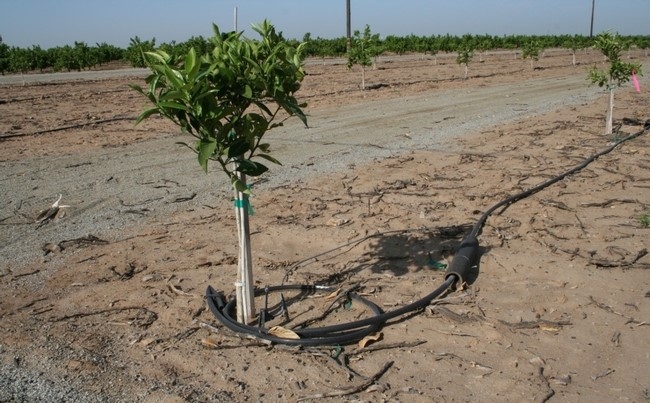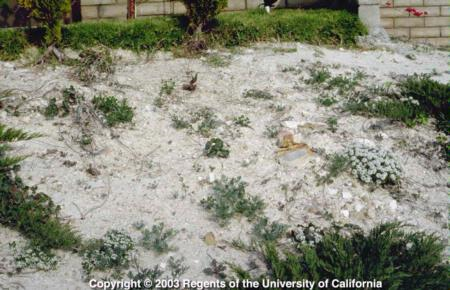
Posts Tagged: acidity
Soil and Water pH Affect Root Health in HLB Citrus
At the recent HLB Conference in Florida a paper was given that reinforces the need for appropriate soil and water pH to maximize root density and tree health. The industry there is dominated by a range of rootstocks and by Valencia-like varieties. Jim Graham and colleagues have shown that pH contributes to orchard health in their HLB situation. This should be a reminder for California growers for general tree health. Florida soils tend to be more coarse than soils found in many California orchards. It's much harder to change soil pH with acidified irrigation water with heavier textured soils.
4.b.1 Soil and water acidification sustain root density of huanglongbing-infected trees in Florida
Jim GRAHAM, Kayla GERBERICH, Diane BRIGHT, Evan JOHNSON
University of Florida, Citrus Research and Education Center, Lake Alfred, Florida, USA
Abstract: Early symptoms of HLB include fibrous root loss and leaf blotchy mottle, followed by premature fruit and leaf drop, and yield decline. As a consequence of initial bacterial infection of fibrous roots, a 30-50% reduction in fibrous root density and elevated soil Phytophthora populations were detected in field surveys. Continued sampling of Hamlin and Valencia orange trees on Swingle citrumelo rootstock in different stages of HLB decline revealed that root loss occurs in two stages. The second phase of root loss (70-80%) begins at the early stage of tree canopy thinning resulting from leaf drop and branch dieback. A more extensive survey of HLB-affected groves indicated that greater decline in fibrous root health and expression of HLB symptoms is observed where irrigation water is high in bicarbonates (> 100 ppm) and/or soil pH > 6.5. HLB symptom expression of trees on different rootstocks follows the known intolerance to bicarbonate (Swingle citrumelo > Carrizo citrange > sour orange > Cleopatra mandarin). Acidification of irrigation water in central ridge and south central flatwoods Valencia orange groves on Swingle citrumelo rootstock for three seasons has maintained soil pH below 6.5 on the flatwoods and 6.0 on ridge. Over the last three seasons of survey, root density as an index of root heath has been sustained. Phytophthora populations remain below the damaging level in ridge groves and in flatwoods increase to damaging levels coincident with the fall root flush but drop back to non-damaging levels for remainder of the season. Compared to the 2013-14 season, yields in the ridge blocks have increased up to 4% and on the flatwoods have increased up to 22%.Growers using acidification treatments with sulfuric and/or N-phuric acid for the last 3 seasons report an average cost of $60 per acre. This cost will analyzed in relation to yield response to provide a cost benefit of acidification
Non-Technical Summary: Managements have been implemented to reduce soil, nutrient and water stress, and Phytophthora root rot. They include frequent irrigation cycles, fertigation and acidification of irrigation water and soil to reduce rhizosphere pH, and fungicides. Root density of trees under these practices fluctuates seasonally and annually but has not declined over the past 3 years. Trees managed with soil acidification and fertigation have steadily recovered in health and yield.
http://www.icc2016.com/images/icc2016/downloads/Abstract_Book_ICC_2016.pdf

citrus
Calcareous Soil Confusion
Calcareous soils have often more than 15% CaCO3 in the soil that may occur in various forms (powdery, nodules, crusts etc…). They are relatively widespread in the drier areas of the earth. California is notable for its young soils, that is, soils that have a relatively high level of nutrients because low rainfall means that natural productivity has not been leached out. The potential productivity of calcareous soils is high where adequate water and nutrients can be supplied. Water is the most limiting input to making California soils productive.
The high pH associated with these soils, though, is not the level of calcium present. It is the carbonate in the soil or the bicarbonate associated with the waters found in those soils which controls the pH. The high pH then controls the availability of iron, zinc, manganese and copper. These nutrients need to be added as foliars or soil applied, or better yet, the soil pH needs to be dropped to around 7 to make these nutrients available.
Recently someone asked if replacing the calcium with potassium would change the pH. No, it won't. The carbonate needs to be removed. Calling it a calcareous soil confuses people about what caused the high pH. The carbonate or bicarbonate needs to be removed with acidification, it turning it into CO2 gas. This is done with urea sulfuric acid or sulfuric or sulfurous acid. There are actually magnesium dominated soils in the San Luis Obispo area that have high pHs due to carbonates. They are carbonateceous.

calcareous soil
